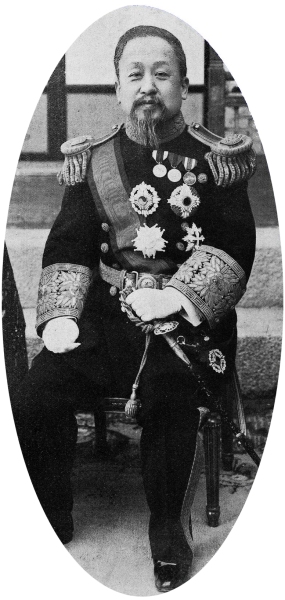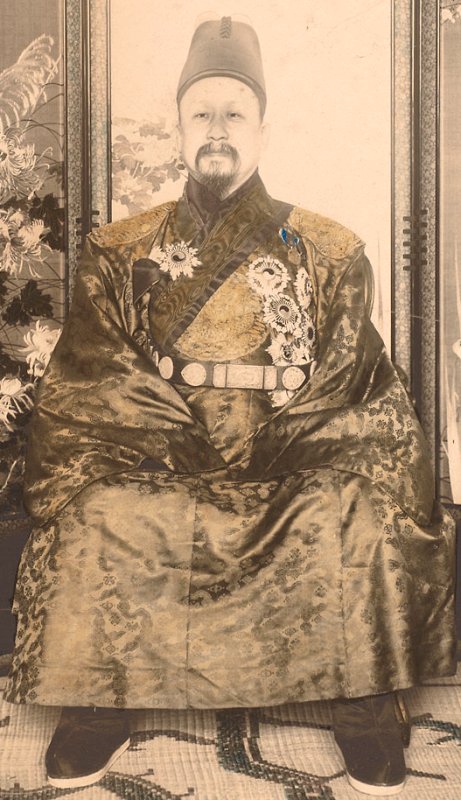

The following table was drawn from the book “Korean Empire Era, Decoration System” 대한제국시대 훈장제도.1 While the book lists most of the Award Recipients by name, it does not list recipients who were immediate members of the royal family,2 and it does not list any recipients for the Commemorative Medals 기념장. There is a table similar to this on page 210, but if you check the totals in that table, the numbers are off for several of the rows and columns. This table was built from the lists of recipients found on pages 115 through to page 209.
There are no known records showing that an Order of the Purple Falcon was ever issued.
For the Order of the Auspicious Phoenix, there were a total of 77 issued. Except for a damaged breast star, there are no known originals that still exist. The Michael Quigley collection did have an original case and sash for the Order. The original damaged breast star is in a private collection.
I have been looking at the Empire Orders and Commemorative Medals for more than 25 years. To date, I have never seen an 8th Class of the Order of Taeguk (51 issued). All of them were issued in Aug. 1910, the last month of the Korean Empire.
Pictured at left is the Emperor Kwangmu. There are numerous websites that list the Emperor’s Korean awards as the Order of the Golden Measure and the Order of the Plum Blossom. This picture appears to show him wearing the Breast Star for the Order of Taeguk on his upper right. I have never seen this award attributed to him on any website. The sash under it is for the Order of the Golden Measure.3
His foreign awards include:
- Italy: Grand Cross of the Order of Saints Maurice and Lazarus 성 마우리치오 & 나사로 훈장 – July 23, 1895
- France: Grand Cross of the Legion of Honour 레지옹 도뇌르 훈장 – July 23, 1895
- Japan: Grand Cordon of the Order of the Chrysanthemum – March 23, 1897
- United Kingdom: Honorary Grand Commander of the Order of the Indian Empire – December 17, 1900
- Spain: Grand Cross of the Order of Charles III, with Collar – 1900 (Exact date unknown)
- Belgium: Grand Cordon of the Royal Order of Leopold 레오폴드 훈장 – March 23, 1901
- Denmark: Knight of the Order of the Elephant – August 31, 1903
- China: Order of the Double Dragon, Class I Grade I – December 1, 1903
- Russia: Knight of the Order of St. Stanislaus, 1st Class – December 1, 1903
- German Empire: Knight of the Order of the Black Eagle – March 20, 1904
- Japan: Korean Annexation Medal – August 1, 1912
The location of his foreign awards is unknown. There was a palace fire in the Daejojeon (大造殿) recorded on Nov. 10, 1917 in which valuable items, described as “Honors (勳記), Medals (勳章), Insignia (徽章), and Commemorative Medals (記念章)” were destroyed.4 This could possibly explain what happened to his Awards, but I have no information of substance. There is a Wikipedia page that says it’s true. The same page says that the Orders could not be passed down to one’s descendants, but again, I have no information of substance.
Emperor Kwangmu’s successor, Emperor Sunjong, was not quite as fortunate when it came to receiving foreign awards. He received the Japanese Grand Cordon of the Order of the Chrysanthemum on Jan. 6, 1901, and the Collar on Oct. 17, 1917. He also received the Korean Annexation Medal on Aug. 1, 1912. From Belgium he received Grand Cordon of the Royal Order of Leopold.
| | ||||||||||||||
| Grand Cordon of the Order of the Golden Measure | ||||||||||||||
| Grand Cordon of the Order of the Auspicious Stars | ||||||||||||||
| Grand Cordon of the Order of the Plum Blossom | ||||||||||||||
I have found an error in the table above. It shows an Order of the Auspicious Phoenix, 1st Class being issued in 1907. When you check the listing of recipients, you will find that this order was issued to Yoshimichi Hasegawa 長谷川好道 (장곡천호도) on March 12, 1907. However, If you check the Annals of the Chosŏn Dynasty 조선왕조실록 (朝鮮王朝實錄) for that date, you will find that he was issued the Order of the Auspicious Stars, not the Auspicious Phoenix. The Order of the Auspicious Phoenix was instituted 18 days later on March 30, 1907. The first awards of the Order of the Auspicious Phoenix were issued on Oct. 5, 1905. This can be substantiated in the Annals of King Kojong. The recipients were Lady Eom 純獻皇貴妃嚴 (1854-1911) who gave birth to Prince Yeongchin 懿愍皇太子 and the other recipient was Kim Su-deok 김수덕 (金修德 1880 – 1964) who was the wife of Yi Kang 이강 (1877 – 1955) also known as Imperial Prince Ui 의친왕. Because these two ladies were immediate members of the Royal Family, they do not show up in the Medal Rolls of the Korean Empire.
| Austria | 오스트러아 | |||||||||||||
| China (Ching Dynasty) | 청 (청나라) | |||||||||||||
| England | 영국 | |||||||||||||
| France | 프랑스 | |||||||||||||
| Germany | 독일 | |||||||||||||
| Italy | 이탈러아 | |||||||||||||
| Japan | 일본 | |||||||||||||
| Korea | 한국 | |||||||||||||
| Norway | 노르웨이 | |||||||||||||
| Philippines | 필리핀 | |||||||||||||
| Russia | 러시아 | |||||||||||||
| Sweden | 스웨덴 | |||||||||||||
| United States | 미귝 | |||||||||||||
I have no explanation for why the totals for the two tables above are different. Both tables came from the same source.5
| The Order of: | |||
| Golden Measure | |||
| Auspicious Stars | |||
| Plum Blossom | |||
| Taeguk or Eight Trigrams | |||
| Purple Falcon | |||
| Auspicious Phoenix | |||
Footnotes:
- Yi Kang-chil 이강칠 (李康七) (1999), publisher 백산출판사, pp. 115 – 211.
- As an example, there were 25 awards of the Order of the Golden Measure; however, the recipient list does not include: the Emperor Kwangmu 광무, the Emperor Sunjong 순종 and the Crown Prince, Heir Apparent Yi Un 이은
- Picture from the Alice Roosevelt Longworth Collection of Photographs from the 1905 Taft Mission to Asia. Located in the Freer Gallery of Art and Arthur M. Sackler Gallery Archives, Smithsonian Institution.
- The exact translation is “All valuable items, Honors, Medals, Insignia, and Commemorative Medals stored in the inner palace were lost”. (The term 내전 can be translated as “civil war”, but here it refers to the penetralia, the innermost (or most secret) part of a building; an inner sanctum; a sanctum sanctorum.) 內戰期間儲存的所有貴重物品、勳章、勳章、徽章、紀念章全部遺失。(Korean: 내전에 소장되어 있던 귀중 물품 및 훈기(勳記), 훈장(勳章), 휘장(徽章), 기념장(記念章) 등이 모두 함께 소실(燒失)되었다.)
- Yi Kang-chil 이강칠 (李康七) (1999), publisher 백산출판사, pp. 210 – 211.
